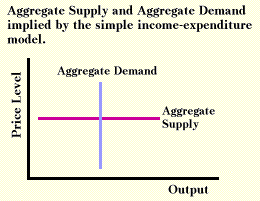Activism
A second important implication of the multiplier model is that government must take an active role in an economy. Keynes rejected the view of Adam Smith that, left alone, a market system generally functions well, or that the "invisible hand" works. An important reason for the pessimistic views of Keynes was his assumption about prices.
The simple multiplier model suggests that what happens in the market for goods and services is the key to understanding macroeconomic problems, but in analyzing this market, it completely ignores prices. Price level is not determined within the model, and in simple models it was assumed to be constant. Assuming fixed prices takes away the primary way that adjustment to equilibrium happens in microeconomics.
Assuming prices constant or fixed makes the model mesh poorly with microeconomic theory. If there is unemployment, microeconomic theory suggests that wages will fall, and this will change the amount of unemployment. If we want to assume that prices are in fact not very flexible, we need to carefully justify this assumption in some way to make it compatible with microeconomic theory. However, for many years this assumption was not properly justified, and as a result, microeconomics and macroeconomics were largely independent fields of study. The independence of the multiplier model from price theory was illustrated in textbooks of the 1950s and 1960s when discussion of macroeconomics preceded discussion of price theory or microeconomics.1 One does not need to know anything about price theory to understand the simple multiplier model.
To see the problem that fixed prices give us, let us put the simple multiplier model into an aggregate-supply aggregate-demand framework. In the multiplier model price level is fixed but output is flexible, so that the aggregate-supply curve is a horizontal line. Aggregate demand is in terms of real output, so that the C+I+G value represents aggregate demand, a vertical line. Because price level is determined outside the model, any change in aggregate demand must change output.

If the aggregate-supply curve is horizontal, the model can say nothing about price change, which is a severe limitation because inflation is one of the variables macroeconomics attempts to explain. This assumption of fixed prices was modified in the 1960s so that the aggregate supply curve could slope upward. However, any aggregate-supply curve other than a vertical one implies that there is no tendency for an economy to have an equilibrium of full employment. Rather the model says that an economy can have an equilibrium level of output with large amounts of unemployment if it is left to itself. But the economy does not have to be left to itself —the government can take an active role in managing the macroeconomic behavior of the economy using its tools of fiscal policy to guide the workings of the economy.
Some people have more trust in market processes than they do in political processes, while others have more trust in political processes than they do in market processes. If you understand how the multiplier model tells us to view the world, you should not be surprised that this model appealed to, and was promoted by, the latter group. Those who placed their faith in market processes tended to be hostile to the multiplier model.
In the 1960s and 1970s many economists thought that the Keynesian multiplier model represented fairly well how the macroeconomy performed. We will see in the remaining chapters why faith in this model has waned. Today many economists in the Keynesian tradition believe that while the model is still relevant in the short run when prices do not adjust much, it may be misleading in the long run when prices do adjust.
1 Tradition has preserved this ordering in many texts —textbooks are a conservative force in economics.
Copyright Robert Schenk